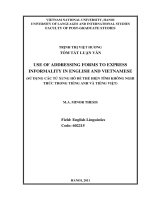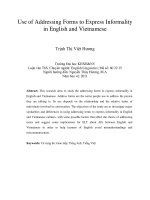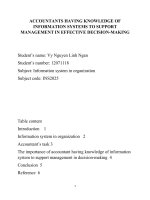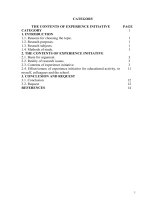Impacts of information technology to value chain in english teaching centers
Bạn đang xem bản rút gọn của tài liệu. Xem và tải ngay bản đầy đủ của tài liệu tại đây (1.21 MB, 119 trang )
Impacts of Information technology
to value Chain in ENGLISH TEACHING
cENTERS
by
TRAN THI THUY VAN
SEPTEMBER 2004
ii
Impacts of Information technology to
value Chain in ENGLISH TEACHING CENTERS
A THESIS SUBMITTED TO
THE HANOI SCHOOL OF BUSINESS
OF
THE VIETNAM NATIONAL UNIVERSITY
BY
TRAN THI THUY VAN
IN PARTIAL FULFILLMENT OF THE REQUIREMENTS FOR THE DEGREE OF
MASTER OF BUSINESS ADMINISTRATION
SEPTEMBER 2004
iii
Approval of the Hanoi School of Business
Truong Gia Binh
Dean
I certify that this thesis satisfies all the requirements as a thesis for the degree of
Master of Business Administration.
President, Examination Committee
This is to certify that we have read this thesis and that in our opinion it is fully
adequate, in scope and quality, as a thesis for the degree of Master of Business
Administration.
Nguyen Viet Anh
Co-Supervisor
Roger Ford
Supervisor
Examination Committee Members
(Title and Name in alphabetical
order of last name)
...............................
_____________________
...............................
_____________________
...............................
_____________________
...............................
_____________________
...............................
_____________________
iv
ABSTRACT
Impacts of Information technology to
value Chain in ENGLISH TEACHING CENTERS
TRAN THI THUY VAN
MBA, Hanoi School of Business
Supervisor : Mr. Roger Ford
Co-Supervisor: Mr. Nguyen Viet Anh
September 2004
This thesis analyzes the strategies of the English Centers to gain competitive
advantage in the technology age.
Keywords: Strategy, Competitive Advantage, Value Chain, Internet, Information
Technology, English Centers…
v
TÓM TẮT
ẢNH HƯỞNG CỦA CÔNG NGHỆ THÔNG TIN TỚI
CHUỖI GIÁ TRỊ CỦA CÁC TRUNG TÂM TIẾNG ANH
Trần Thi Thuý Vân
Hướng dẫn 1: Mr. Roger Ford
Hướng dẫn 2: Mr. Nguyễn Việt Anh
Tháng Chín 2004
Bản luận văn này phân tích chiến lược của các Trung tâm Tiếng Anh để đạt được
lợi thế cạnh tranh trong thời đại công nghệ thông tin.
Từ khóa: Chiến lược, Lợi thế cạnh tranh, Chuỗi giá trị, Internet, Công nghệ thông
tin, Trung tâm Tiếng Anh
vi
To My Parents
vii
ACKNOWLEDGMENTS
I express sincere appreciation to Mr. Roger Ford, Mr Nguyen Viet Anh and Mr.
Ha Nguyen for their guidance and insight throughout the research. Thanks go to
the other faculty members, Professor Roger Ford, Mr. Jubin Kapur, Ms. Tran
Phuong Lan, Dr. Ta Ngoc Cau, Mr. Meghnad Shetty for their suggestions and
comments. The
assistance of Ms. Huyen Huong, and Ms. Phuong Thao is
gratefully acknowledged.
To my parent , I offer
sincere thanks
for their
unshakable faith in me and their willingness to endure with me the vicissitudes
of my endeavors.
viii
TABLE OF CONTENTS
INTRODUCTION ............................................................................................ 1
LITERATURE REVIEW ................................................................................ 7
2.1. COMPETITIVE ADVANTAGE ..................................................... 7
2.2. INFORMATION TECHNOLOGY AND COMPETITIVE
ADVANTAGE .............................................................................................. 8
2.3. VALUE CHAIN ............................................................................... 11
2.3.1. What is value chain? ................................................................. 11
2.3.2. Impact of Information Technology on Value Chain ............... 20
2.4. DIFFERENTIATION ..................................................................... 30
METHODOLOGY ......................................................................................... 44
3.1.
3.2.
3.3.
3.4.
3.5.
3.6.
3.7.
RESEARCH PROBLEM ................................................................ 44
RESEARCH OBJECTIVE ............................................................. 44
RESEARCH METHOD .................................................................. 45
RESEARCH STRATEGY .............................................................. 45
SAMPLE SELECTION .................................................................. 45
DATA COLLECTION .................................................................... 45
DATA ANALYSIS........................................................................... 46
EMPIRICAL DATA PRESENTATION ..................................................... 47
4.1. ENGLISH TRAINING IN VIETNAM .......................................... 47
4.2. CASE STUDY ONE – LANGUAGE LINK VIETNAM .............. 49
4.2.1. Background ............................................................................... 49
4.2.2. Information technology in Language Link ............................. 50
4.2.3. Value Chain and Information Technology .............................. 51
4.2.4. Differentiation and Information Technology .......................... 53
4.3. CASE STUDY TWO – SITC .......................................................... 57
4.3.1. Background ............................................................................... 57
4.3.2. Information technology in SITC .............................................. 58
4.3.3. Value Chain and Information Technology .................................. 59
4.3.4. Differentiation and Information Technology .......................... 62
4.4. CUSTOMER SAMPLE RESEARCH ........................................... 66
University .................................................................................................. 68
Item ........................................................................................................... 69
DATA ANALYSIS ......................................................................................... 72
5.1. QUANLITATIVE ................................................................................. 72
5.1.1. Information technology and Value Chain ............................... 73
ix
5.1.2. Source of differentiation ........................................................... 76
5.2. QUANTITATIVE ..................................................................................... 80
CONCLUSIONS AND IMPLICATIONS ................................................... 81
6.1. FINDINGS, CONCLUSIONS AND RECOMMENDATION ON
RESEARCH QUESTIONS ........................................................................ 81
6.2. IMPLICATIONS ............................................................................. 83
x
LIST OF TABLES
Table 1 – The age of the students in the Sample ........................................... 66
Table 2- Places of students ............................................................................... 67
Table 3 - The students from Universities ........................................................ 68
Table 4 – Student’s expense for learning English............................................ 69
Table 5 – The need for communicating English .............................................. 69
xi
LIST OF FIGURES
Figure 1. Porter’s Generic Value Chain ........................................................... 13
Figure 2 - The Value System (Porter) .............................................................. 14
Figure 3 - Virtual Value Chain......................................................................... 21
Figure 4 - Comparison of Transmission Mediums .......................................... 25
Figure 5 - Traditional view of the value chain ................................................. 26
Figure 6 - The Value Chain with the customer ................................................ 27
Figure 7 - Source of Differentiation in the Value Chain.................................. 35
Figure 8 - Virtual Value Chain for Language Link Vietnam. .......................... 73
Figure 9 - Source of Differentiation in the Value Chain in Language Link Vietnam
.................................................................................................................. 76
Figure 10 - Virtual Value Chain for SITC ...................................................... 74
Figure 11 - Source of Differentiation in the Value Chain in SITC .................. 78
xii
VITA
Ms. Tran Thi Thuy Van received her B.A. degree in Foreign Trade from the
Vietnam National University (VNU) in July 2000. She worked in a Joint Stock
Company as an accountant and a project Manager assistant from 2001 to 2002. At
the period of learning full-time MBA Program in Hanoi School of business, she has
participated in a number of projects at Vietnam Country Gateway Project funded by
World Bank, Vietnam Competitiveness Initiative Project funded by USAID,
Citibank (United States), Soil and Water Ltd (Finland)…
1
CHAPTER 1
INTRODUCTION
1.1. Competitive Advantage
Competitive advantage is important for companies to perform in competitive
market. Competitive determines the appropriateness of a firm’s activities that can
contribute to its performance, such as innovations, culture, or good implementation.
There are two basic kinds of competitive advantage: cost leadership or
differentiation. Competitive advantage in either cost or differentiation is a function
of a company’s value chain.
A company’s cost position reflects the collective cost of performing all its value
activities relative to rivals. Each value activity has cost drivers that determine the
potential sources of a cost adavantage. Some firms view the differentiation in
physical product or marketing practices, but differentiation should be viewed from
anywhere in the value chain.
1.2. Competitive Advantage and Information Technology
Recently, entrepreneurs, executives, investors and industries in worldwide as well
as in Vietnam has paid much attention on E-business and E-commerce. With the
help of information technology, the processes and operations of businesses can be
shortenned. The Internet has offerred not only the advantage of low cost but also
provide the smooth and linkage between different business activities. Many
organizations worldwide has integrate Internet technology to redesign their business
processes in ways that can strengthen their competitive advantages.
2
Businesses are incorporating electronic commerce into strategic plans, business
schools are incorporating it into their curriculum, and consulting and software firms
are marketing electronic commerce “solutions”. So what exactly is electronic
commerce? Greenstein and Feinman define Electronic Commerce as: “the use of
electronic transmission mediums (telecommunications) to engage in the exchange,
including buying and selling, of products and services requiring transportation,
either
physically or digitally, from location to location. (Source: Greenstein, Feinman,
2000, “Electronic Commerce: Security, Risk Management and Control”. New York:
The McGraw-Hill Companies, Inc.)
Electronic commerce involves all sizes of transaction bases. As one would expect,
electronic commerce requires the digital transmission of transaction information.
While transactions are conducted vie electronic devices, they may be transported
using either traditional physical shipping channels, such as a ground delivery
service, or digital mechanisms, such as the download of a product from the Internet.
The Internet and the world wide web provide the mechanisms to foster the growth
of electronic commerce. The actual growth rates and uses of the Internet indicate
that electronic commerce is no passing fad, but rather a fundamental change in the
way in which busnesses interact with one another and their consumers. Please look
at the General Electric example. In 1997, General Electric purchased approximately
USD 1 billion worth of supplies using the Internet. Some benefits that GE has
realized due to its Internet procurement system are a 50% reduction in the
purchasing cycle and a 30% reduction in processing costs. General Electric
Company’s 1997 Internet activity clearly demonstrate the electronic commerce can
provide substantial, tangible benefits to a firm when implemented properly.
3
Another concept is E-business. It includes the exchange of information not directly
related to the actual buying and selling of goods. Businesses are using electronic
mechanism to distribute information and provide customer support.
What benefits can business potentially gain from engaging in electronic commerce?
They are: more affordable, more business partners to be reached, Internet and webbased electronic commerce can reach a more geographically dispersed customer
base, procurement processing costs can be lowered, cost of purchases can be
lowered, reductions in inventories, lower cycle times, better customer service and
lower sales and marketing costs.
Internet technology is changing the way many firm do business. With the help of
Information technology, especially Internet, there are two ways for businesses to
gain sustainable competitive advantage. One is operational effectiveness – doing the
same thing your competitors do but doing them better. Operational effectiveness
advantages include better technologies, superior inputs, better-trained people or a
more effective management structure. The other way to achieve advantage is
strategic positioning—doing things differently from competitors, in a way that
delivers a unique type of value to customers. This can mean offering a different set
of features, a different array of services, or different logistical arrangements.
(Porter, 2001, “Strategy and the Internet”, Harvard Business Review, Vol, 79,
No.3. Page 63-78).
The Internet affects operational effectiveness and strategic positioning in very
different ways. It makes it harder for companies to sustain operational advantages,
but it opens new opportunities for achieving or strengthening a distinctive strategic
positioning.
The Internet is the powerful tool available today for enhancing operational
effectiveness. By easing and speeding the exchange of real-time information, it
4
enables improvements throughout the entire value chain, across almost every
company and industry. And because it is an open platform with common standards,
companies can often tap into its benefits with much less investment than was
required to capitalize on past generations of information technology.
However, easy access to Internet technology brings new challenges to competitive
advantages. Business are now looking for ways to differentiate themselves from
their competitors. Creating competitive advantages is vital to sustaining growth.
In Vietnam, the concept of E-commerce, E-business is still new. According to the
Vietnamnews article on Octocber, 2003, A Mekong Project Development Facility
survey concluded that only 3 percent of Vietnamese businesses used some aspect of
e-commerce, 7 percent intended to use e-commerce and the remaining 90 percent
had little knowledge of E-commerce. According to www.vietnamwebsite.net, there
are only 3,400 (5% of 70,000 businesses in Vietnam) have their own website.
Businesses in Vietnam in the infancy stage of E-business will consider Internet as a
kind of operational effectiveness but they should bear in their mind that operational
effectivenesss is not sustainable. With the lesson and experience in worldwide,
Vietnamese businesses that would like to succeed must find the ways to
differentiate themselves from their competitors with the help of information
technology.
It is clear that the trend of integrating information technology into businesses to
gain competitive advantage is not advoidable not only worldwide but also in
Vietnam, the economy in the infant stage of e-commerce and e-business. Recently,
E-commerce is only applied in Vietnam to exchange information, seek partners and
introduce and advertise goods and services. But in the future, those businesses that
can integrate information technology into its value chain and make it become a
5
competitive advantage can be outperformed and can compete not only in Vietnam
but also in global.
1.3. Competitive Advantage and Value Chain
Competitive advantage stems from the many discrete activities a firm performance
in designing, producing, marketing, delivering and supporting its product. Each of
these activities contributes to a firm’s relative cost position and creates a basis for
differentiation. The Value Chain is an important concept to highlight the role of
information technology in competition. A systematic ways of examining all the
activities a firm performs and how they interact is necessary for analyzing the
source of competitive advantages. The value chain devide a firm into its relevant
activities in order to understand the behaviour of costs and the existing and potential
sources of differentiation. A firm gain competitive advantages by performing these
activities more cheaply or better than competitors.
The ultimate purpose of value chain is to analyze to identify appropriate means of
differentiation for a firm so that it can provide superior value to the customers. A
firm, as a collection of activities, is a collection of technologies Technology can be
in every value activity in a firm and technological change can affect competition
through its impact on any activities.
The value chain is used to demonstrate how a value chain can be constructed for a
particular firm, reflecting the specific activities it performs. Differences among
competitor value chain are a key source of competitive advantage. It is nescessary
to define a firm’s value chain for competing in a particular industry. The value
chain is a basic tool for finding competitive advantage and ways to create and
sustain it.
6
Every firm including Vietnamese firms that seeks to be successful in the future is
striving to implement Internet technology. It is important for every type of
organization to improve efficiency and be better than competitors. For this reason
the purpose of this thesis is to analyze the question how companies in Vietnam
especially specific English Centers apply Information Technology into its value
chain to get differentiation.
Because the concept of E-commerce, E-business is still new in Vietnam, it is a
broad concept and is under discussion in Vietnam, the scope of this thesis is only
focusing on the impact of information technology to the value chain of English
Teaching Centers.
The Thesis consists of 6 Chapters:
In Chapter 1, we give a broad description and provide a discussion of issue related
to the problem area.
In Chapter 2, literature review is given to provide theories relevant for the problem
area.
Chapter 3 represents methodology for data collection and analysis.
In Chapter 4, there is empirical data presentation, consists of background of the
companies and data collected. We choose Language Link and SITC because they
are big enough to apply Information technology and they are two of the first English
Centers applied Information technology in some activities of their business.
Language Link is the company with high price service and SITC is company with
premium price service.
In Chapter 5, the data is analyzed and conclusions are given in Chapter 6.
7
CHAPTER 2
LITERATURE REVIEW
2.1.
COMPETITIVE ADVANTAGE
Competitive advantage describes the way a firm can choose and implement a
generic strategy to achieve and sustain competitive advantage. The competitive
advantage can come from cost advantage or differentiation advantage and the scope
of a firm’s activities. Value chain is the basic tool for diagnosing competitive
advantage and finding ways to enhance it. Competitive advantages is about a firm
actually puts the generic strategies into practice.
About cost leadership, there are various sources of cost advantage which are lower
input costs, lower in-plant production costs and lower delivery costs. However, this
advantage can be eroded when there are rising costs. Therefore, the advantage of
differentiation offer superior performance. The differentiation can give many
dimensions that can be exploited in seeking to establish a product or service
superior to its competition.
Competitive advantage can arise from many sources, and show how all advantages
can be connected to specific activities and the way that activities relate to each
other, to supplier activities and to customer activities. Advantage resting on a few
activities is easier to diagnose and often easier to imitate. Only the tie linkage of
many activities is difficult to imitate.
8
2.2.
INFORMATION TECHNOLOGY AND COMPETITIVE
ADVANTAGE
Information revolution is sweeping through the economy. No company can escape
its effects. Dramatic reduction in the cost of obtaining, process, and transmitting
information are changing the way we do business. The technology is transforming
the nature of products, processes, companies, industries, and even competition
itself. Every company must understand the broad effects and implications of the
new technology and how it can create substantial and sustainable competitive
advantages.
Organizations today frequently integrate Internet technology to redesign processes
in ways that strengthen their competitive advantages. Before information
technology, the costs for communicating, gathering information, or accomplishing
transactions is high. The Internet’s greatest impact has been to enable the
reconfiguration of industries and businesses.Many organizations are able to
integrate activities of their value chain encompassing suppliers, customers, and
distribution channels within an industry or across industries. With the rate of
technological change in the global economy, technology and information have
become as critical as capital, research and development, marketing and other
previous drivers of success. Companies that thrive and survive in this global
marketplace will be information based. Vietnamese firms that want to suceed
locally as well as globally have to not ignore the importance of information
technology impact.
Business can gain sustainalbe competitive advantages by two ways. One is
operational effectiveness, and another way is to achieve advantage of strategic
positioning. The Internet affects operational effectiveness and strategic positioning
in very different ways. It makes it harder for companies to sustain operational
advantages but it gives new opportunities for achieveing or strengthening a
9
distintive strategic positioning. Simply improving operational effectiveness does not
provide a competitive advantage. Companiess only gain advantages if they are able
to achieve and sustain higher levels of operational effectiveness than competitors.
That is an exceedingly difficult proposition even in the best of circumstances. Once
a company establishes a new best practice, its rivals tend to copy it quickly. Best
practice competition eventually leads to competitive convergence, with many
companies doing the same things in the same ways. The nature of Internet
applications makes it more difficult to sustain operational advantages than ever. The
openness of the Internet, combined with advances in software architecture,
development tools, and modularity, makes it much easier for companies to design
and implement applications. Many companies have forgotten what they stand for
and rushed to implement hot Internet applications and copy the offerings of dotcoms. (Porter, 2001, “Strategy and the Internet”, Harvard Business Review, Vol,
79, No.3. Page 63-78).
Therefore, the important concept that highlights the role of information technology
in competition is the “value chain”. To gain competitive advantage over its rivals, a
company must either perform these activities at a lower cost or perform them in a
way that leads to differentiation and a premium price. Information technology has a
powerful effect on competitive advantage in either cost or differentiation. The
technology affects value activities themselves or allows companies to gain
competitive advantage by exploiting changes in competitive scope.
About lowering cost, information technology can alter a company’s costs in any
part of the value chain. About enhancing differentiation, The role of a company and
its product in the buyer’s value chain is the key determinant of differentiation. The
new information technology makes it possible to customize products. By bundling
more information with the physical product package sold to the buyer, the
technology affects a company’s ability to differentiate itself.
10
Internet provides a better technological platform to reinforce a distintive strategy,
tailoring activities and enhancing it. Package software application were hard to
customize, and companies were often forced to change the way they conduct
activities in order to conform to the best practices in the software. It is also difficult
for company to connect discrete applications to one another. Internet architecture,
together with other improvements in software architecture and development tools,
has turned IT into a far more powerful tool for strategy. It is much easier to
customize packaged Internet applications to a company’s unique strategic
positioning. By providing a common IT delivery platform across the value chain,
Internet architecture and standards also make it possible to build truly integrated
and customized systems that reinforce the fit among activities in the value chain.
In addition, the technology also increases a company’s ability to coordinate its
activities regionally, nationally and globally. Internet has permitted companies to
develop new and more effective days of responding to customer needs. E-commerce
marketers can significantly increase the number of competitive advantage options
available to them by considering the opportunities offered by the dual options of
combining cost leadership with differenctiation and product customisations.
As all the companies come to embrace Internet technology, the Internet itself will
be neutralized as a source of advantage. Basic Internet applications will become
table stakes – companies will not be able to survive without them, but they will not
gain any advantage from them. The more robust competitive advantages will arise
instead from traditional strengths such as unique products, propretary content,
distinctive physical activities, superior product knowledge, and strong personal
service and relationships. Internet technology may be able to fortify those
advantages, by tying a company’s activities together in a more distinctive system,
but it is unlikely to supplant them. Internet technology provides better opportunities
11
for companies to establish distinctive strategic positionings than did previous
generations of information technology.
2.3.
VALUE CHAIN
As we have mentioned in the earlier part, value chain is the basic tool for
diagnosing competitive advantage. The ultimate purpose of the value chain analysis
is to identify appropriate means of differentiation for a firm so that it can provide
superior delivered value to its customers. Value chain is also the basic tool for
understanding the influence of information technology on companies. It is the set of
activities through which a product or service is created and delivered to customers.
When a company competes in any industry, it performs a number of discrete but
interconnected value-creating activities, such as operating a sales force, delivering
products and these activities have points of connection with the activities of
suppiers, channels and customers. The value chain is a framework for identifying all
these activities and analyzing how they affect both a company’s costs and the value
delivered to buyers.
2.3.1. What is value chain?
Value chain is the basic tool for diagnosing competitive advantage and finding ways
to enhance it. The value chain disaggregateds a firm into its relevant activities in
order to understand the behaviour of costs and the existing and potential sources of
differentiation. A firm gains competitive advantage by performing these important
activities more cheaply or better than its competitors. Since no two firms, even in
the same industry, compete in exactly the same set of markets with exactly the same
set of suppliers, the overall value chain for each firm is unique.
Value chain analysis describes the activities within and around an organization, and
relates them to an analysis of the competitive strength of the organization.
Therefore, it evaluates which value each particular activity adds to the organizations
12
products or services. This idea was built upon the insight that an organization is
more than a random compilation of machinery, equipment, people and money. Only
if these things are arranged into systems and systematic activates it will become
possible to produce something for which customers are willing to pay a price. Porter
argues that the ability to perform particular activities and to manage the linkages
between these activities is a source of competitive advantage. (Michael Porter.
1998. Competitive Advantage: creating and sustaining Superior Performance. New
York: Free Press)
Porter distinguishes between primary activities and support activities. Primary
activities are directly concerned with the creation or delivery of a product or
service. They can be grouped into five main areas: inbound logistics, operations,
outbound logistics, marketing and sales, and service. Each of these primary
activities is linked to support activities which help to improve their effectiveness or
efficiency. There are four main areas of support activities: procurement, technology
development (including R&D), human resource management, and infrastructure
(systems for planning, finance, quality, information management etc.).
The basic model of Porters Value Chain is as follows:
13
Figure 2.1. Porter’s Generic Value Chain
The value chain is a part of a larger value system that incorporates all value-added
activities from raw materials to components and final assembly through buyer
distribution channels. Suppliers have value chain (upstream value) that create and
deliver the purchased inputs used in a firm’s chain. Suppliers not only deliver a
product but also can influence a firm’s performance in many other ways. In
addition, many products pass through the value chains of channels (channel value)
on their way to the buyer. Channels perform additional activities that affect to the
buyer, as well as influence the firm’s own activities. A firm’s product eventually
becomes part of its buyer’s value chain. A firm can enhance its design to
distribution – but also by understanding how the firm’s value activities fit into the
supplier’s and customer’s value chains.
The value-chain partnership is a strong and close alliance in which one company or
unit forms a long-term arrangement with a key supplier or distributor for mutual
advantage. Value-chain partnerships are becoming extremely popular as more
companies and business units outsource activities that were previously done within









